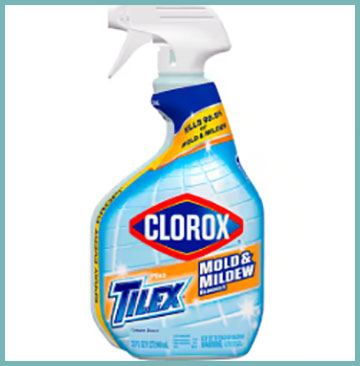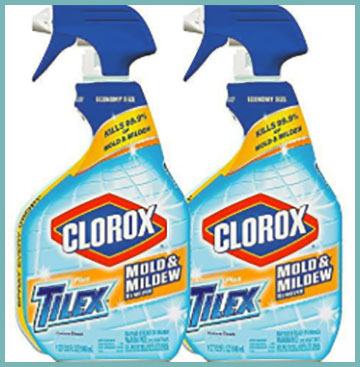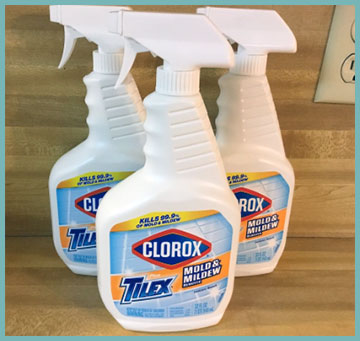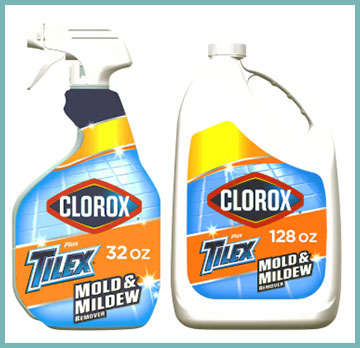I’ve battled mold and mildew in my bathroom for years, and let me tell you, it’s a fight that tests your patience. When I stumbled across Tilex Mold and Mildew Remover, I was skeptical but desperate for something that actually worked.
Spoiler alert: it’s now a staple in my cleaning arsenal. If you’re tired of scrubbing endlessly or dealing with stubborn black spots creeping across your shower tiles, you need to give Tilex a try. This spray promises to tackle mold and mildew with minimal effort, and I’m here to share why it’s worth grabbing a bottle.
My Experience With Tilex Mold and Mildew Remover

Let me set the scene: my bathroom shower had become a battleground.
Black mold spots were creeping along the grout lines, and no amount of scrubbing with a generic cleaner seemed to help.
I’d heard about Tilex Mold and Mildew Remover from a friend who swore by it, so I picked up a 32-ounce bottle from my local hardware store.
The first thing I noticed was the spray bottle’s design—it felt sturdy, with a nozzle that let me adjust the spray pattern. I was ready to put this stuff to the test.
I sprayed Tilex directly onto the moldy grout in my shower, making sure to coat every inch of the affected area.
The instructions said to let it sit for about 10 minutes before rinsing, so I set a timer and opened the bathroom window to deal with the strong bleach smell.
I’m not going to lie—the scent hit me like a wave. It’s potent, like standing in a pool supply store, but I expected that from a bleach-based cleaner.
After 10 minutes, I grabbed my showerhead and rinsed the area.
To my shock, the black spots were gone.
Like, completely gone. No scrubbing, no elbow grease, just a quick rinse, and my grout looked almost brand-new.
I decided to test Tilex further on the caulking around my bathtub, which had some stubborn mildew stains. Same deal: spray, wait, rinse. The results were just as impressive.
The caulk went from dingy to bright white in minutes. I even tried it on the vinyl shower curtain, which had some funky spots near the bottom.
Again, Tilex worked like a charm, though I made sure to rinse it quickly to avoid any damage to the material. One thing I learned fast—don’t let it sit too long on non-recommended surfaces like rubber or vinyl, as it can be a bit too aggressive.
Over the next few weeks, I used Tilex regularly to keep mold at bay. I noticed that the mold didn’t come back as quickly as it used to with other cleaners. It’s not a permanent fix—mold loves moisture, so it’s always lurking—but Tilex made maintenance so much easier.
The only downside was the sprayer. On my second bottle, the nozzle got stuck and leaked a bit, which was annoying. I had to transfer the liquid to another spray bottle, but that was a minor hiccup compared to the results. Overall, Tilex felt like a game-changer for someone like me who dreads cleaning but hates mold even more.
Read More: My Thoughts On Weiman Stone And Tile Cleaner
Pros Of Tilex Mold and Mildew Remover
- Highly effective on mold and mildew: This stuff lives up to its promise. It obliterates mold and mildew on contact, often without any scrubbing. My shower grout and caulk looked brand-new after one use, and it tackled even the stubborn black spots that other cleaners couldn’t touch. It’s a lifesaver for anyone dealing with persistent bathroom fungi.
- Fast-acting formula: You don’t have to wait forever to see results. In about 10 minutes, Tilex does its magic. I sprayed it on, went to make a coffee, and came back to a mold-free shower. That kind of speed is perfect for busy people who don’t want to spend hours cleaning.
- Versatile for multiple surfaces: Tilex works on a range of non-porous surfaces like ceramic tiles, grout, fiberglass, and even vinyl shower curtains. I used it on my sink and countertop stains too, and it handled them with ease. Just be cautious on sensitive materials, and always rinse thoroughly.
- Prevents regrowth for weeks: Unlike some cleaners that only mask the problem, Tilex seems to keep mold at bay for longer. I noticed a significant reduction in how quickly mold returned to my shower, which saved me from constant cleaning sessions.
- Easy-to-use spray bottle: The adjustable nozzle makes application a breeze. You can switch between a wide mist for large areas or a focused stream for tight corners. It’s user-friendly, even if you’re not a cleaning pro.
The power of Tilex lies in its bleach-based formula, which cuts through mold and mildew like a hot knife through butter. I was genuinely impressed by how little effort it required to transform my bathroom. The fact that it’s EPA-registered and kills 99.9% of common household bacteria, like Staph and Strep, gave me extra peace of mind. For anyone who’s ever felt defeated by bathroom mold, Tilex is like having a secret weapon. Sure, the smell is strong, but the results are worth it. It’s become my go-to for keeping my bathroom fresh and mold-free.
Cons Of Tilex Mold and Mildew Remover

- Strong bleach smell: Let’s be real—the scent is intense. If you’re sensitive to chemical odors, Tilex’s bleach-heavy formula might make you wince. I had to open windows and turn on a fan every time I used it. A mask helps, but it’s not exactly a pleasant experience.
- Not safe for all surfaces: Tilex is great for non-porous surfaces, but it’s not meant for wood, painted surfaces, or fabrics. I accidentally got some on a towel, and it left a bleached spot. You’ve got to be careful where you spray it, or you’ll regret it.
- Sprayer issues: The “every last drop” nozzle sounds great in theory, but it’s not perfect. My second bottle’s sprayer got stuck and leaked, which was frustrating. I’ve read similar complaints online, so it’s not just me. Be prepared to possibly transfer it to another bottle.
- Smaller bottle size: The 16-ounce bottle feels a bit stingy for the price. Compared to other brands that offer 32 ounces for a similar cost, Tilex can feel like you’re getting less bang for your buck. I went through the smaller bottle quickly in my large bathroom.
- Requires ventilation and caution: This isn’t a spray-and-forget product. You need good airflow to avoid inhaling fumes, and prolonged skin contact can irritate. I learned to wear gloves after my hands felt a bit dry post-cleaning. It’s effective, but you’ve got to respect its potency.
While Tilex is a powerhouse, it’s not flawless. The strong smell and potential for sprayer malfunctions are real drawbacks, especially if you’re cleaning in a poorly ventilated space or on a budget. Still, these issues didn’t outweigh the benefits for me, but they’re worth considering before you buy.
Maintenance Tips For Tilex Mold and Mildew Remover

- Use weekly for best results: To keep mold and mildew from staging a comeback, make Tilex part of your weekly cleaning routine. I spray it on my shower tiles and grout every Sunday, let it sit for 10 minutes, and rinse. This keeps my bathroom looking pristine and prevents those black spots from creeping back. Consistency is key with mold—it thrives in damp environments, so don’t give it a chance to settle in.
- Ventilate your space: Always open a window or turn on a fan before spraying Tilex. The bleach fumes are no joke, and proper airflow makes the process safer and more comfortable. I also leave the bathroom door open to let the smell dissipate faster. If you’ve got a small, windowless bathroom, consider using a mask to avoid irritation.
- Rinse thoroughly after use: Tilex needs to be rinsed off, especially on surfaces like vinyl or rubber, to prevent damage. I made the mistake of letting it sit too long on my shower curtain, and it started to feel brittle. Use your showerhead or a damp cloth to rinse every trace of the product after it’s done its job.
- Store properly to avoid leaks: That sprayer can be finicky, so store the bottle upright in a cool, dry place. I keep mine in a plastic bin under the sink to catch any potential leaks. If the nozzle starts acting up, transfer the liquid to a new spray bottle to save yourself the hassle.
- Check for underlying issues: Tilex is great at removing mold, but it won’t fix the root cause. I noticed my bathroom stayed mold-free longer after I fixed a leaky faucet and improved ventilation with a better exhaust fan. Regularly check for leaks or damp spots to make Tilex’s job easier and keep your space healthy.
Using Tilex effectively is all about being proactive and cautious. By incorporating it into a regular cleaning schedule and addressing moisture issues, you can maximize its mold-fighting power. It’s not just about cleaning—it’s about creating an environment where mold doesn’t stand a chance. These steps have helped me keep my bathroom sparkling, and I’m confident they’ll work for you too.
Comparison With Other Brands

- RMR-141 Disinfectant Spray: RMR-141 is a solid contender in the mold-fighting world, and I gave it a whirl to see how it stacked up against Tilex. Unlike Tilex, RMR-141 is bleach-free, which is a huge plus if you’re sensitive to chemical smells. It has a mild citrus scent that’s much easier on the nose, and I didn’t need to ventilate my bathroom as aggressively. It’s EPA-registered and kills 99.9% of bacteria and fungi, just like Tilex, but it’s designed to stick to surfaces longer, which can be great for tough stains.
- Mold Armor Mold Remover: Mold Armor is another popular choice, and I tested its 32-ounce spray bottle to compare. Like Tilex, it’s bleach-based, so it’s got that same potent punch for tackling mold and mildew. I used it on my shower tiles, and it worked well, though I noticed it needed a bit more scrubbing than Tilex for deeply embedded stains. The bottle size is a win—Mold Armor offers more product for a similar price, making it feel like a better value. The downside? Its sprayer was even less reliable than Tilex’s, clogging after just a few uses. The smell was also just as strong, so you’re not escaping the bleach fumes. If budget is a concern, Mold Armor is a strong alternative, but Tilex’s ease of use kept me loyal.
- CLR Mold & Mildew Clear Stain Remover: CLR’s bleach-free formula caught my attention, especially since it’s EPA Safer Choice certified, meaning it’s a bit kinder to the environment. I tried it on my bathroom sink and some outdoor patio tiles. It worked decently on light mildew but struggled with the black mold in my shower grout compared to Tilex. You have to let it sit for a few minutes and scrub, which was a letdown after Tilex’s no-scrub promise. The lack of bleach makes it safer for fabrics and porous surfaces, but it’s less versatile for heavy-duty bathroom cleaning. If you’re looking for an eco-friendly option for lighter stains, CLR is great, but for serious mold, Tilex is the heavyweight champ.
- Concrobium Mold Control Spray: Concrobium was my wildcard pick, as it’s marketed as a mold preventer rather than just a remover. I sprayed it on my bathroom ceiling after using Tilex to clean existing mold, hoping it would keep things under control. It’s odorless and bleach-free, which was a relief after Tilex’s fumes, and it’s safe for a wider range of surfaces, including fabrics. However, it’s not as effective at removing existing stains—you’ll need a separate cleaner for that. I liked its preventive angle, but it felt like an extra step rather than a standalone solution. Tilex’s all-in-one approach was more practical for my needs, but Concrobium could be a good add-on for maintenance.
Each of these brands has its strengths, but Tilex’s combination of speed, effectiveness, and ease of use made it my top pick. If you prioritize eco-friendliness or need a larger bottle, you might lean toward CLR or Mold Armor, but for sheer mold-killing power, Tilex is hard to beat.
Read More: My Thoughts On Star Brite Mildew Stain Remover
Frequently Asked Questions (FAQ)
Absolutely, Tilex works like a charm for most mold and mildew issues. I sprayed it on my shower grout and saw black spots vanish in 10 minutes with no scrubbing. It’s EPA-registered and kills 99.9% of common household bacteria and fungi, making it a reliable choice for bathroom cleaning. However, it’s not a cure-all—severe mold over large areas might need professional attention, and you’ll need to address moisture issues to prevent regrowth.
Tilex is my top pick for its speed and no-scrub effectiveness, especially on tough stains. Compared to RMR-141, Mold Armor, CLR, and Concrobium, Tilex delivers the fastest results on non-porous surfaces like tiles and grout. If you want a bleach-free option, RMR-141 or CLR might suit you better, but they often require more scrubbing. For sheer power and ease, Tilex takes the crown, though your choice depends on your specific needs and surface types.
Yes, Tilex requires rinsing, especially on surfaces like vinyl, rubber, or plastic, to prevent damage. I learned this the hard way when I left it on my shower curtain too long, and it felt brittle. Spray it, let it sit for 10 minutes, then rinse thoroughly with water. For disinfecting hard, non-porous surfaces, let it sit for five minutes before rinsing to ensure it kills mold and bacteria effectively.
Yes, Tilex contains sodium hypochlorite (bleach), which is why it’s so effective at killing mold and whitening stains. The bleach gives it that strong smell and makes it unsuitable for fabrics or porous surfaces like wood. Always use it in a well-ventilated area and wear gloves to avoid skin irritation. The bleach is what makes Tilex a powerhouse, but it’s also why you need to be cautious with it.
Conclusion: For Tilex Mold and Mildew Remover
If you’re staring down mold and mildew in your bathroom, Tilex Mold and Mildew Remover is your best bet. It’s fast, effective, and cuts through grime with minimal effort, saving you time and frustration.
Despite the strong smell and occasional sprayer issues, the results are unmatched. Grab a bottle, open a window, and watch those ugly stains disappear. Your bathroom deserves to shine, and Tilex makes it happen without breaking a sweat.
